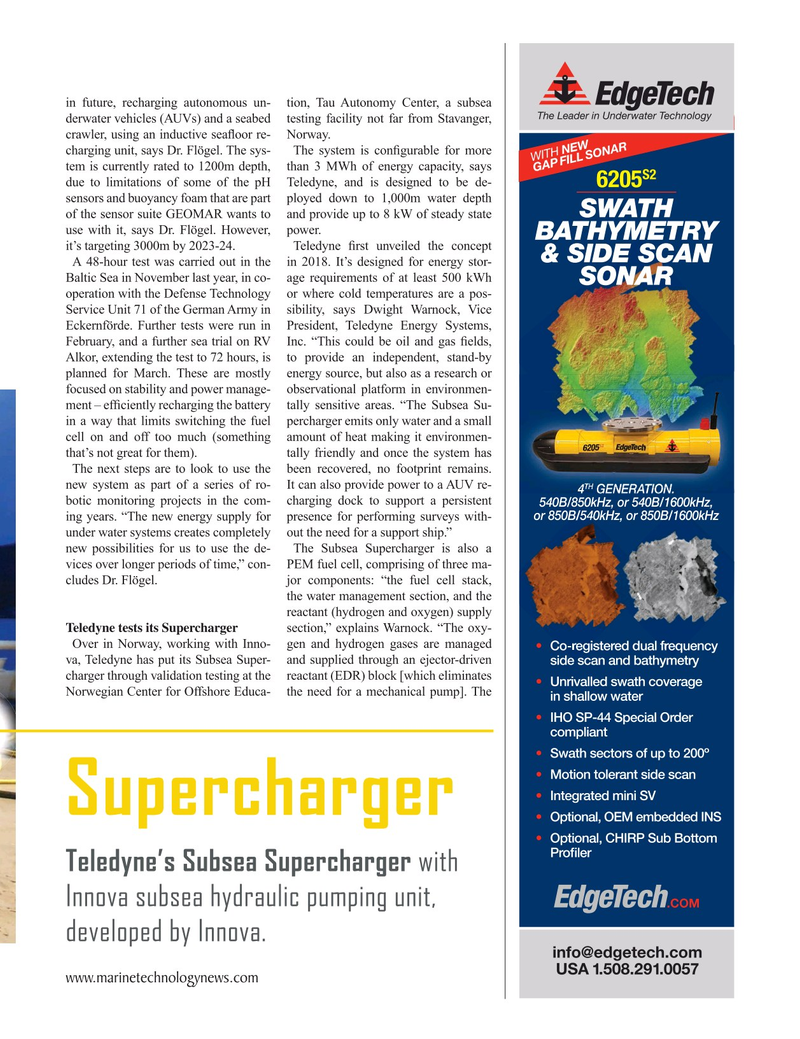
Page 31: of Marine Technology Magazine (March 2022)
Read this page in Pdf, Flash or Html5 edition of March 2022 Marine Technology Magazine
in future, recharging autonomous un- tion, Tau Autonomy Center, a subsea derwater vehicles (AUVs) and a seabed testing facility not far from Stavanger, crawler, using an inductive sea? oor re- Norway. charging unit, says Dr. Flögel. The sys- The system is con? gurable for more
WITH NEW tem is currently rated to 1200m depth, than 3 MWh of energy capacity, says
GAP FILL SONAR
S2 due to limitations of some of the pH Teledyne, and is designed to be de- 6205 sensors and buoyancy foam that are part ployed down to 1,000m water depth
SWATH of the sensor suite GEOMAR wants to and provide up to 8 kW of steady state use with it, says Dr. Flögel. However, power.
BATHYMETRY it’s targeting 3000m by 2023-24. Teledyne ? rst unveiled the concept & SIDE SCAN
A 48-hour test was carried out in the in 2018. It’s designed for energy stor-
Baltic Sea in November last year, in co- age requirements of at least 500 kWh
SONAR operation with the Defense Technology or where cold temperatures are a pos-
Service Unit 71 of the German Army in sibility, says Dwight Warnock, Vice
Eckernförde. Further tests were run in President, Teledyne Energy Systems,
February, and a further sea trial on RV Inc. “This could be oil and gas ? elds,
Alkor, extending the test to 72 hours, is to provide an independent, stand-by planned for March. These are mostly energy source, but also as a research or focused on stability and power manage- observational platform in environmen- ment – ef? ciently recharging the battery tally sensitive areas. “The Subsea Su- in a way that limits switching the fuel percharger emits only water and a small cell on and off too much (something amount of heat making it environmen- that’s not great for them). tally friendly and once the system has
The next steps are to look to use the been recovered, no footprint remains. new system as part of a series of ro- It can also provide power to a AUV re-
TH 4 GENERATION.
botic monitoring projects in the com- charging dock to support a persistent 540B/850kHz, or 540B/1600kHz, or 850B/540kHz, or 850B/1600kHz ing years. “The new energy supply for presence for performing surveys with- under water systems creates completely out the need for a support ship.” new possibilities for us to use the de- The Subsea Supercharger is also a vices over longer periods of time,” con- PEM fuel cell, comprising of three ma- cludes Dr. Flögel. jor components: “the fuel cell stack, the water management section, and the reactant (hydrogen and oxygen) supply
Teledyne tests its Supercharger section,” explains Warnock. “The oxy-
Over in Norway, working with Inno- gen and hydrogen gases are managed • Co-registered dual frequency and supplied through an ejector-driven va, Teledyne has put its Subsea Super- side scan and bathymetry charger through validation testing at the reactant (EDR) block [which eliminates • Unrivalled swath coverage
Norwegian Center for Offshore Educa- the need for a mechanical pump]. The in shallow water • IHO SP-44 Special Order compliant • Swath sectors of up to 200º • Motion tolerant side scan • Integrated mini SV
Supercharger • Optional, OEM embedded INS • Optional, CHIRP Sub Bottom 3URðOHU
Teledyne’s Subsea Supercharger with
Innova subsea hydraulic pumping unit, developed by Innova.
www.marinetechnologynews.com
MTR #3 (18-33).indd 31 2/25/2022 1:25:37 PM

 30
30

 32
32
